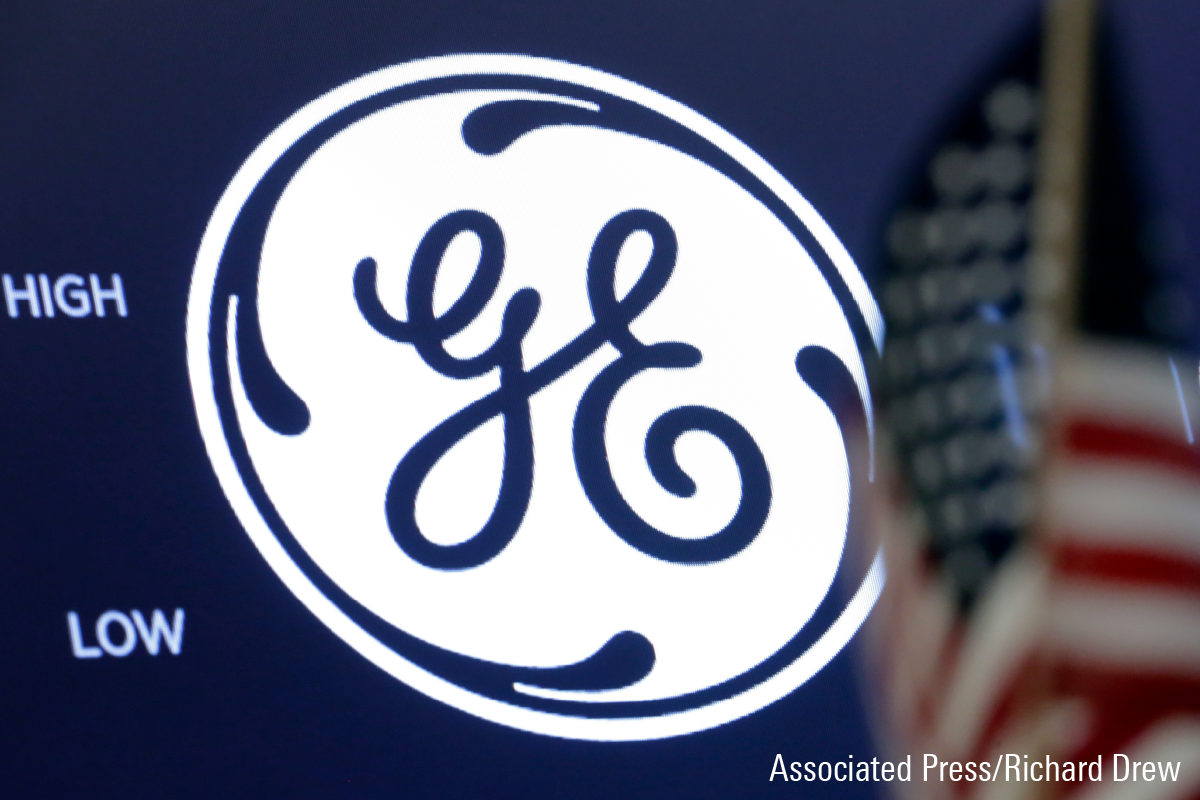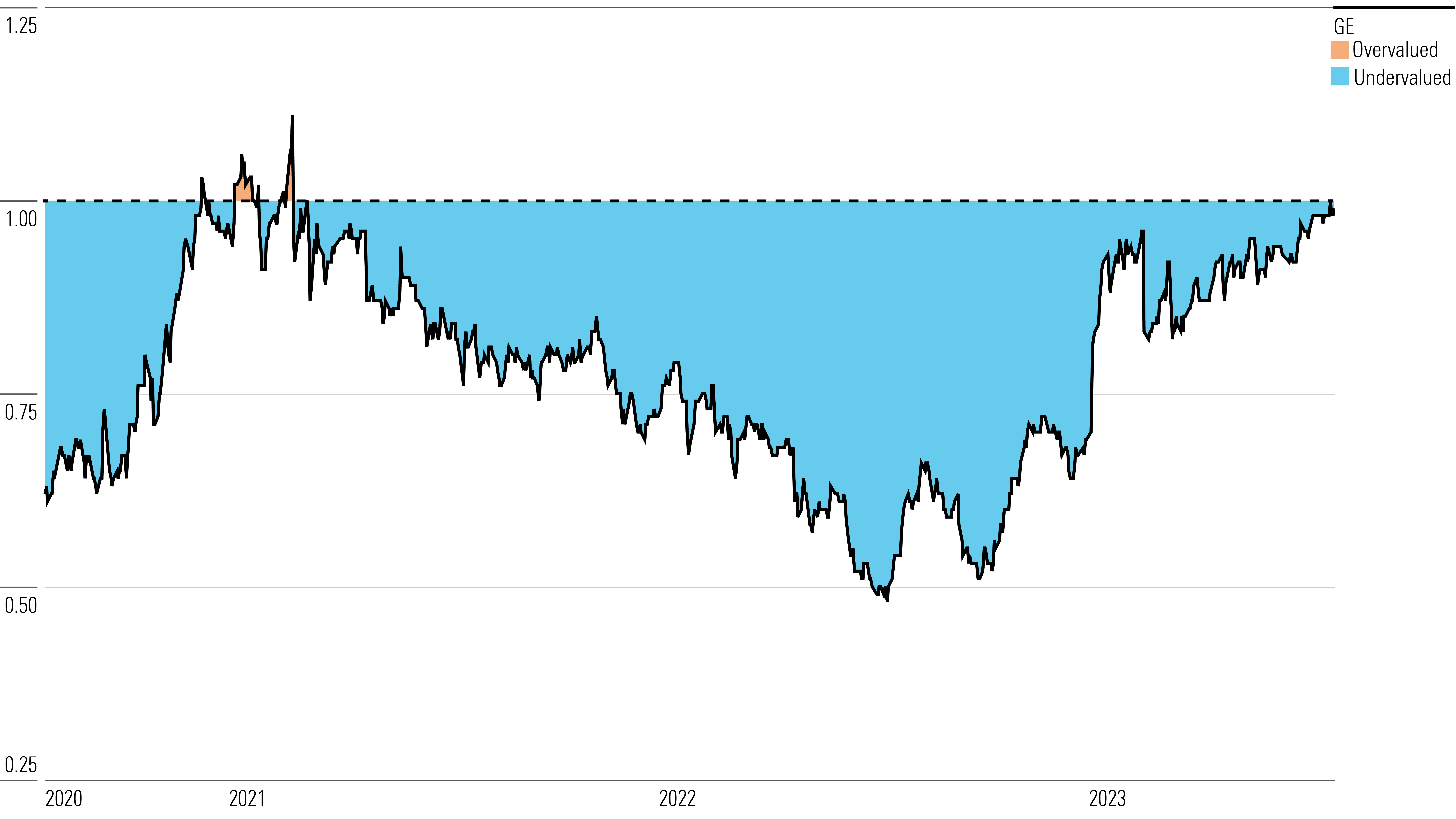After Earnings and a Big 2023 Rally, Is GE Stock a Buy, a Sell, or Fairly Valued?
With GE crushing Q2 estimates and shares up more than 50% this year, here’s what we think of its stock.

General Electric GE released its second-quarter earnings report on July 25, 2023. Here’s Morningstar’s take on what to think of GE’s earnings and stock.
Key Morningstar Metrics for GE
- Fair Value Estimate: $117.00
- Morningstar Rating: 3 stars
- Morningstar Economic Moat Rating: Narrow
- Morningstar Uncertainty Rating: High
What We Thought of GE’s Q2 Earnings
- GE crushed our second-quarter estimates. In the near term, we are a little more bullish on the company’s aerospace division. We think GE is better positioned to work through supply chain issues than most in the industry.
- The most meaningful differences from our top-line estimates came from Renewables, led by higher grid and offshore wind equipment revenue. At the margin level, Aerospace operating profits cruised past our expectations. These exceptional results were thanks to commercial service revenue on strong external part sales and internal shop visits.
- While we’re convinced GE will continue to perform strongly over the long term (and this is reflected in our estimates), we no longer believe the stock represents a compelling value for investors. In fact, the market has now removed its previously embedded deal limbo, meaning it’s not waiting for next year’s spinoff to assign full credit to intrinsic value. Furthermore, the debate in the stock has mostly settled, as we glean from even the more bearish of estimates.
General Electric Stock Price
Fair Value Estimate for GE
With its 3-star rating, we believe GE’s stock is fairly valued compared with our long-term fair value estimate.
We have lifted our fair value estimate for GE to $117 per share from $113. In the first half of 2023 alone, the firm’s earnings exceeded what it produced in its prior full-year results, excluding GE HealthCare.
We also raised our 2023 adjusted earnings per share expectations to $2.42 (or 12 cents above the high end of management’s revised range) and a free cash flow of $4.6 billion. Our more bullish sentiment reflects an expectation of low-double-digit organic plus sales growth in 2023.
Read more about GE’s fair value estimate.
GE Historical Price/Fair Value Ratio

Economic Moat Rating
We assign GE a narrow economic moat based on switching costs and intangible assets stemming from its massive installed base of industrial equipment and differentiated technology. We hold off on assigning a wide moat because of our lack of confidence in our 20-year hurdle rate for excess return on capital.
GE Aerospace, the company’s crown jewel, meets our highest standard of a wide-moat business. The segment benefits from intangible assets and switching costs, and we think it is the premier commercial engine manufacturer that can deliver at scale. GE competes in a virtual duopoly in both the wide-body (twin-aisle) and narrow-body (single-aisle) space against Rolls-Royce and Pratt & Whitney.
In the formative years after a new engine launch (about one-third of the overall cost of a new plane), GE will typically implement an estimated 70% discount on its new narrow-body engines from their listed prices. Over time, these discounts erode. A typical jet engine will then first require service in about year seven of operation, at which time an engine program may pass breakeven and become a recurring and enviable profit stream for GE. These bespoke service contracts typically extend for 25 years.
We believe intangible assets are particularly critical for engine deliveries—the razor in the razor-and-blade model. The technical knowledge needed to design and manufacture a jet engine is GE’s main source of intangible assets. This technical know-how is supported by the firm’s research and development budget, of which about one-third is principally funded by the U.S. government. Other intangible assets include the firm’s patents, a long record of success, and its customer relationships with both Boeing (primarily) and Airbus. A record of success can have a disproportionate impact on delivery wins.
After GE Aerospace, GE’s competitive position fares far worse, with its other businesses facing secular pressure. GE Power faces pricing pressures and a shifting energy mix in its end markets toward renewables.
Read more about GE’s economic moat rating.
Risk and Uncertainty
GE’s principal risk is related to the fallout of COVID-19 on its commercial aerospace business, including government interventions and acceleration of infections that ultimately affect both revenue passenger kilometers (demand) and load factors (utilization).
Additional risks include GE’s significant cash burn amid pricing pressures in some of its operating businesses, including renewable energy, and its insurance liabilities (though they’ve been less of a concern in recent years, given rising interest rates).
Finally, GE has a large key-person risk in CEO H. Lawrence Culp. In our view, losing him before a successful turnaround would pose critical headline and fundamental risk.
Read more about GE’s risk and uncertainty.
GE Bulls Say
- Bears vastly underestimate the incremental profits GE will make from operating leverage when commercial aerospace fully recovers and the windfall from the Inflation Reduction Act.
- We believe GE is led by the premier U.S. multi-industry CEO. Culp has assembled a team of leaders who are steadily changing GE’s culture to embrace lean principles.
- GE’s installed base boasts the youngest fleet, with nearly 50% of its CFM fleet yet to make its first shop visit. This bodes well for its high-margin aftermarket business.
GE Bears Say
- GE’s turnaround has a lot of unknowns, including when renewables will finally reach profitability and when the Inflation Reduction Act will move toward full implementation.
- While GE will generate orders from the energy transition, it has consistently made negative earnings from both Power and Renewables, and new equipment orders will only pressure and dilute margins further.
- Bulls vastly underestimate the amount of contingent liabilities GE will have to contend with.
This article was compiled by Lauren Solberg.
The author or authors do not own shares in any securities mentioned in this article. Find out about Morningstar’s editorial policies.


/cloudfront-us-east-1.images.arcpublishing.com/morningstar/N7VBPGEKIZDBPEAHLKIWYNRLBE.png)
/cloudfront-us-east-1.images.arcpublishing.com/morningstar/MQJKJ522P5CVPNC75GULVF7UCE.jpg)
/cloudfront-us-east-1.images.arcpublishing.com/morningstar/ZYJVMA34ANHZZDT5KOPPUVFLPE.png)